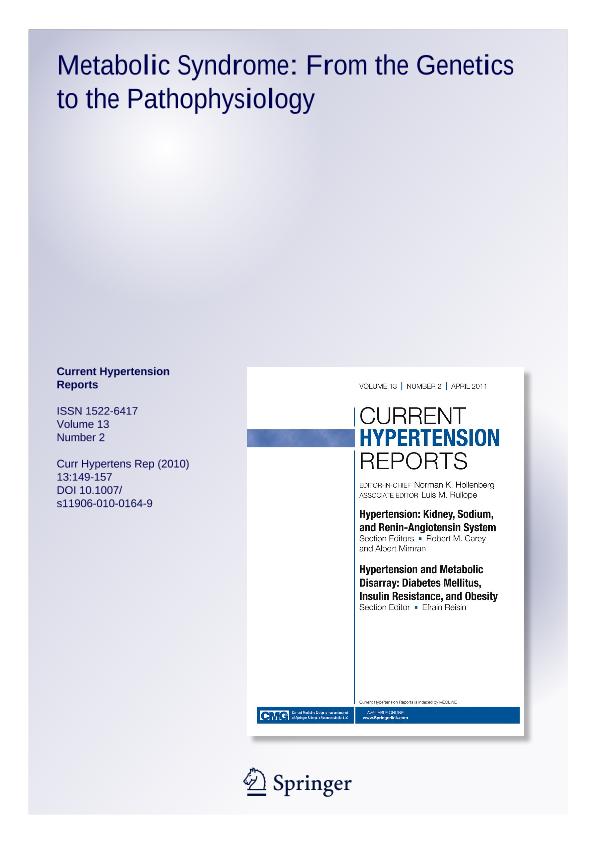Mostrar el registro sencillo del ítem
dc.contributor.author
Sookoian, Silvia Cristina

dc.contributor.author
Pirola, Carlos Jose

dc.date.available
2017-04-10T19:09:39Z
dc.date.issued
2011-04
dc.identifier.citation
Sookoian, Silvia Cristina; Pirola, Carlos Jose; Metabolic syndrome: from the genetics to the pathophysiology; Springer; Current Hypertension Reports; 13; 2; 4-2011; 149-157
dc.identifier.issn
1522-6417
dc.identifier.uri
http://hdl.handle.net/11336/15097
dc.description.abstract
The metabolic syndrome (MS) constitutes a combination of underlying risk factors for an adverse outcome, cardiovascular disease. Thus, the clinical behavior of the MS can be regarded as a whole. Nevertheless, from a pathogenic point of view, understanding of the underlying mechanisms of each MS intermediate phenotype is far beyond their understanding as an integrative process. Systems biology introduces a new concept for revealing the pathogenesis of human disorders and suggests the presence of common physiologic processes and molecular networks influencing the risk of a disease. This paper shows a model of this concept to explain the genetic determinants of MS-associated phenotypes. Based on the hypothesis that common physiologic processes and molecular networks may influence the risk of MS disease components, we propose two systems-biology approaches: a gene enrichment analysis and the use of a protein-protein interaction network. Our results show that a network driven by many members of the nuclear receptor superfamily of proteins, including retinoid X receptor and farnesoid X receptor (FXR), may be implicated in the pathogenesis of the MS by its interactions at multiple levels of complexity with genes associated with metabolism, cell differentiation, and oxidative stress. In addition, we review two alternative genetic mechanisms that are gaining acceptance in the physiopathology of the MS: the regulation of transcriptional and post-transcriptional gene expression by microRNAs and epigenetic modifications such as DNA methylation.
dc.format
application/pdf
dc.language.iso
eng
dc.publisher
Springer

dc.rights
info:eu-repo/semantics/openAccess
dc.rights.uri
https://creativecommons.org/licenses/by-nc-sa/2.5/ar/
dc.subject
Cardiometabolic Syndrome
dc.subject
Insulin Resistance
dc.subject
Obesity
dc.subject
Hypertension
dc.subject
Diabetes
dc.subject
Arterial Blood Pressure
dc.subject
Glucose
dc.subject
Insulin
dc.subject
Triglycerides
dc.subject
Cholesterol
dc.subject
Dyslipidemia
dc.subject
Genetics
dc.subject
Gene
dc.subject
Variants
dc.subject
Epigenetics
dc.subject
Dna Methylation
dc.subject
Systems Biology
dc.subject
Mirnas
dc.subject
Slc7a1
dc.subject
Clock
dc.subject
Slc6a4
dc.subject
Epistasis
dc.subject
Small for Gestational Age
dc.subject
Newborns
dc.subject
Adolescents
dc.subject.classification
Gastroenterología y Hepatología

dc.subject.classification
Medicina Clínica

dc.subject.classification
CIENCIAS MÉDICAS Y DE LA SALUD

dc.title
Metabolic syndrome: from the genetics to the pathophysiology
dc.type
info:eu-repo/semantics/article
dc.type
info:ar-repo/semantics/artículo
dc.type
info:eu-repo/semantics/publishedVersion
dc.date.updated
2017-04-07T15:16:47Z
dc.identifier.eissn
1534-3111
dc.journal.volume
13
dc.journal.number
2
dc.journal.pagination
149-157
dc.journal.pais
Alemania

dc.journal.ciudad
Berlín
dc.description.fil
Fil: Sookoian, Silvia Cristina. Universidad de Buenos Aires. Facultad de Medicina. Instituto de Investigaciones Médicas; Argentina. Consejo Nacional de Investigaciones Cientificas y Tecnicas. Oficina de Coordinacion Administrativa Houssay. Instituto de Investigaciones Medicas; Argentina
dc.description.fil
Fil: Pirola, Carlos Jose. Universidad de Buenos Aires. Facultad de Medicina. Instituto de Investigaciones Médicas; Argentina. Consejo Nacional de Investigaciones Cientificas y Tecnicas. Oficina de Coordinacion Administrativa Houssay. Instituto de Investigaciones Medicas; Argentina
dc.journal.title
Current Hypertension Reports

dc.relation.alternativeid
info:eu-repo/semantics/altIdentifier/url/https://link.springer.com/article/10.1007%2Fs11906-010-0164-9
dc.relation.alternativeid
info:eu-repo/semantics/altIdentifier/doi/http://dx.doi.org/10.1007/s11906-010-0164-9
Archivos asociados
